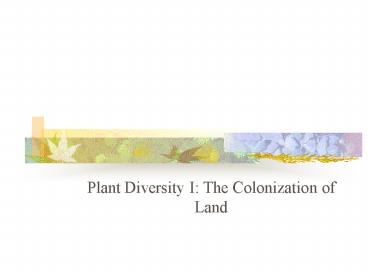Plant Diversity I: The Colonization of Land - PowerPoint PPT Presentation
1 / 23
Title:
Plant Diversity I: The Colonization of Land
Description:
Light and carbon dioxide are available above ground. Water and nutrients are only ... Xylem conducts water upwards. Phloem conducts food both directions ... – PowerPoint PPT presentation
Number of Views:62
Avg rating:3.0/5.0
Title: Plant Diversity I: The Colonization of Land
1
- Plant Diversity I The Colonization of Land
2
An Overview Of Plant Evolution
- Structural, chemical, and reproductive
adaptations enabled plants to colonize land - Plants on land must get resources from two very
different places - Light and carbon dioxide are available above
ground - Water and nutrients are only available in the
soil.
3
Unlike the algae on the left above, land plants
like the tree are not surrounded with everything
they need to survive. They must have special
adaptations to obtain the needed resources
4
- Most plants have leaves to absorb light above
ground - The leaves have numerous openings called stomata
that allow carbon dioxide to enter the leaf, and
oxygen to exit - Cuticles on leaf surfaces help reduce water loss
through transpiration - Roots are designed to absorb water and nutrients
from the soil - Most plants also have special adaptations for
reproducing on land
5
This diagram shows some of the adaptations of
land plants
6
Reproductive adaptations
- Land plants produce gametes within specialized
gametangia - The egg is fertilized within the female
gametangium - The zygote develops into an embryo that is
retained, nourished, and protected - Land plants are often referred to as embryophytes
because of these differences from algal modes of
reproduction
7
The photo above shows an early plant embryo
surrounded by nourishing tissues and a protective
layer of cells
8
This photo shows the plant embryo removed from
the protective seed. Seed plants are the most
successful of all land plants.
9
Alternation of Generations
- The life cycles of all plants feature an
alternation of generations - The gametophyte is the haploid generation
- The sporophyte is the diploid generation
- The gametophyte generation takes turns, or
alternates with the spororophyte generation
10
(No Transcript)
11
Plant Classification
- In plant classification, the term division is
used instead of phylum - Divisions are then subdivided into classes,
orders, families, genera, and species, - There are three major divisions of nonvascular
plants - There are eight major divisions of vascular
plants
12
Nonvascular Plants (Bryophytes)
- Bryophytes include
- Mosses Division Bryophyta
- Liverworts Division Hepatophyta
- Hornworts Division Anthocerophyta
- Bryophytes have no vascular tissue
- Bryophytes require water for reproduction
- Bryophytes have a dominant gametophyte generation
13
Mosses grow in flat, dense mats where there is
sufficient moisture
14
This photo shows the club-like sporophyte growing
on the gametophyte generation
15
Liverworts are related to the mosses . Notice the
different type of sporophyte growing on the
gametophyte shown here.
16
This plant is a hornwort. How can you tell the
hornwort from the moss and liverwort?
17
The life cycle of the moss is typical for
bryophytes. Can you tell where in the life cycle
mitosis and meiosis occur?
18
Vascular Plants
- Vascular plants are distinguished by the presence
of tissues which conduct food and water - Xylem conducts water upwards
- Phloem conducts food both directions
- Vascular plants also have distinctive shoots
above ground and roots below ground - Vascular plants also contain lignin in the cell
wall
19
Seedless Vascular Plants
- The seedless vascular plants include
- Club mosses Division Lycophyta
- Horsetails Division Sphenophyta
- Ferns Division Pterophyta
- These plants also have a dominant sporophyte
generation - Nearly all are homosporous, meaning they produce
only one type of spore - None produce seeds
20
Club mosses are among the most unusual of the
vascular seedless plants. Many grow as epiphytes
on other plants.
21
Horsetails Ferns
22
(No Transcript)
23
Sporangia form on the underside of the frond, or
fern leaf. On the right is a close-up view of the
spore-bearing structures































